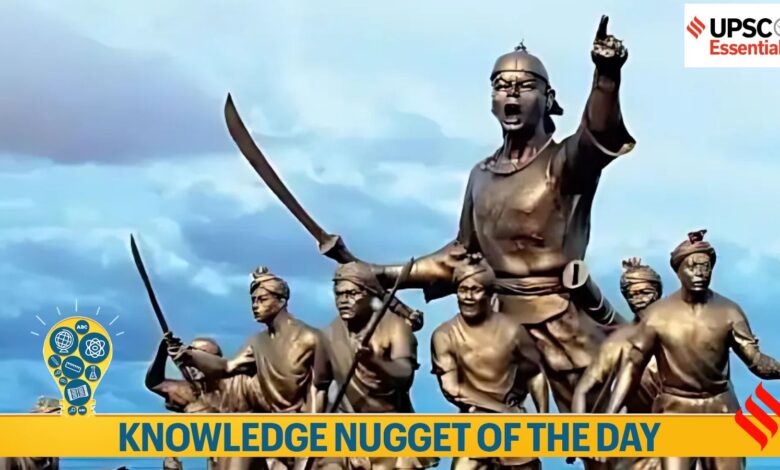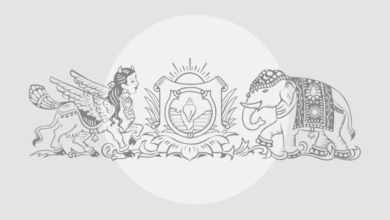Knowledge nugget of the day: Lachit Borphukan

Take a look at the essential events, concepts, terms, quotes, or phenomena every day and brush up your knowledge. Here’s your knowledge nugget for today.
(Relevance: Lachit Borphukan is a significant historical figure. Notably, prominent historical figures, and from time to time UPSC has asked questions about such personalities. Additionally, knowing about Lachit Borphukan is important because his legacy touches upon several important dimensions of India’s history.)
Why in the news?
Every year, 24th November is celebrated as the ‘Lachit Diwas’ to mark the birth anniversary of the Assamese folk hero Lachit Borphukan. He was a legendary army commander of the Ahom kingdom, known for his leadership in the 1671 ‘Battle of Saraighat.’ He is considered one of the greatest of Assamese heroes, symbolising the valour, courage, and intelligence that defines the Assamese self-identity.
Key Takeaways :
1.Lachit Borphukan was a legendary army commander of the Ahom kingdom. He defeated the Mughal forces, led by Raja Ramsingh-I, in the ‘Battle of Saraighat’, and thwarted a drawn-out attempt by them to take back Assam.
2. Son of the great warrior-statesman Momai Tamuli Barbarua, Lachit was born on November 24, 1622, and grew up during a turbulent period of Assam’s history.

3. He was chosen as one of the five Borphukans of the Ahom kingdom by king Charadhwaj Singha, and given administrative, judicial, and military responsibilities.
Lachit Barphukan represented a time when the “Assamese race was united and able to fight an alien, formidable force such as the Mughals” said, Arup Kumar Dutta, author of The Ahoms.
 Prime Minister Narendra Modi unveiled a 125-foot bronze statue of Ahom general Lachit Borphukan at his burial site in eastern Assam’s Jorhat district on March 9, 2024. Veteran sculptor Ram Vanji Sutar, a Padma Bhushan awardee, built the statue, who also crafted the Statue of Unity in Gujarat. (PTI)
Prime Minister Narendra Modi unveiled a 125-foot bronze statue of Ahom general Lachit Borphukan at his burial site in eastern Assam’s Jorhat district on March 9, 2024. Veteran sculptor Ram Vanji Sutar, a Padma Bhushan awardee, built the statue, who also crafted the Statue of Unity in Gujarat. (PTI)
Battle of Alaboi and Saraighat
1. Between 1615 and 1682, the Mughal Empire made a series of attempts, under Jahangir and then Aurangzeb, to annex the Ahom kingdom. In January 1662, Mughal Governor of Bengal Mir Jumla’s forces engaged with the Ahom army and went on to occupy part of the territory under Ahom rule.
2. Between 1667 and 1682, the Ahoms under a series of rulers, starting with Chakradhwaj Singha, (reigned 1663-70) launched a counter-offensive to reclaim lost territories.
3. In 1669, Aurangzeb dispatched the Rajput Raja Ram Singh I to recapture territories won back by the Ahoms. The battle of Alaboi was fought on August 5, 1669 in the Alaboi Hills near Dadara in North Guwahati.
4. While the Mughals preferred an open battle, Borphukan relied on his knowledge of the territory and engaged in guerrilla warfare, which provided an edge to his smaller, but fast moving and capable forces.
5. Much like Shivaji’s encounters with the Mughals in Marathwada, Lachit inflicted damage on the large Mughal camps and static positions. His raids would kill unsuspecting Mughal soldiers and frustrate the mighty armies that were too ponderous to respond swiftly.
6. After initial setbacks, Ram Singh sent his entire battery of Rajput soldiers and Mughal veterans and turned the tide of the battle. Ten thousand Ahoms died in the battle, according to a paper posted on the website of Assam’s archaeology department.
1. The Ahom dynasty ruled over much of Assam and the North East from 1228 to 1826 AD. They were one of India’s longest-reigning ruling dynasties. At their peak, their kingdom stretched from modern-day Bangladesh to deep inside Burma. Known to be able administrators and valiant warriors, the Ahom dynasty has enduring cultural appeal in Assam.
2. Founded by the Sukapha, a 13th-century ruler, Ahom kingdom was a prosperous, multi-ethnic kingdom which spread across the upper and lower reaches of the Brahmaputra valley, surviving on rice cultivation in its fertile lands.
3. The founders of the Ahom kingdom had their own language and followed their own religion. Over the centuries, the Ahoms accepted the Hindu religion and the Assamese language, scholars say.
4. Charaideo was the first permanent capital of the Ahom empire. It was founded by the first most renowned Ahom monarch Chao Lung Siu-Ka-Pha and has always had a major place in history. The word Charaideo is formed from three Tai Ahom words: Che-Rai-Doi. Che signifies city or town, Rai denotes shine or dazzle, and Doi means hill or mountain. In a nutshell, Charaideo means “a shining town situated on a hilltop.”
Sources: Ahom warrior Lachit Borphukan and the battles of Alaboi & Saraighat,
For your queries and suggestions write at roshni.yadav@indianexpress.com
The Indian Express UPSC Essentials brings to you the November issue of its monthly magazine. Click Here to read. Share your views and suggestions in the comment box or at manas.srivastava@indianexpress.com
Subscribe to our UPSC newsletter and stay updated with the news cues from the past week.
Stay updated with the latest UPSC articles by joining our Telegram channel – Indian Express UPSC Hub, and follow us on Instagram and X.







